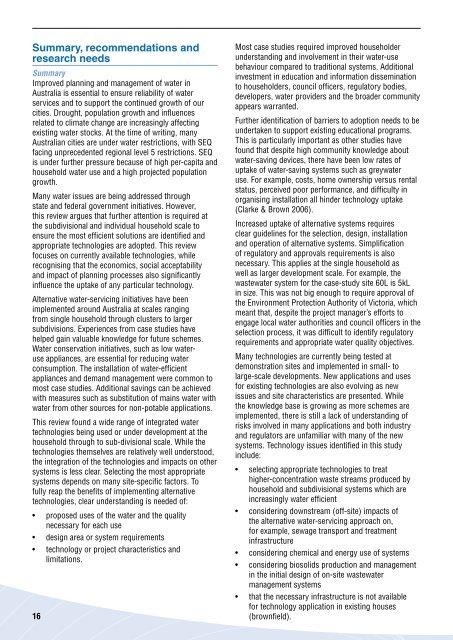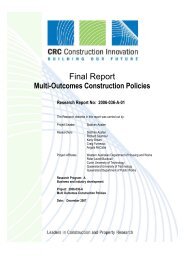Sustainable subdivisions - Construction Innovation
Sustainable subdivisions - Construction Innovation
Sustainable subdivisions - Construction Innovation
- No tags were found...
Create successful ePaper yourself
Turn your PDF publications into a flip-book with our unique Google optimized e-Paper software.
Summary, recommendations andresearch needsSummaryImproved planning and management of water inAustralia is essential to ensure reliability of waterservices and to support the continued growth of ourcities. Drought, population growth and infl uencesrelated to climate change are increasingly affectingexisting water stocks. At the time of writing, manyAustralian cities are under water restrictions, with SEQfacing unprecedented regional level 5 restrictions. SEQis under further pressure because of high per-capita andhousehold water use and a high projected populationgrowth.Many water issues are being addressed throughstate and federal government initiatives. However,this review argues that further attention is required atthe subdivisional and individual household scale toensure the most effi cient solutions are identifi ed andappropriate technologies are adopted. This reviewfocuses on currently available technologies, whilerecognising that the economics, social acceptabilityand impact of planning processes also signifi cantlyinfl uence the uptake of any particular technology.Alternative water-servicing initiatives have beenimplemented around Australia at scales rangingfrom single household through clusters to larger<strong>subdivisions</strong>. Experiences from case studies havehelped gain valuable knowledge for future schemes.Water conservation initiatives, such as low wateruseappliances, are essential for reducing waterconsumption. The installation of water-effi cientappliances and demand management were common tomost case studies. Additional savings can be achievedwith measures such as substitution of mains water withwater from other sources for non-potable applications.This review found a wide range of integrated watertechnologies being used or under development at thehousehold through to sub-divisional scale. While thetechnologies themselves are relatively well understood,the integration of the technologies and impacts on othersystems is less clear. Selecting the most appropriatesystems depends on many site-specifi c factors. Tofully reap the benefi ts of implementing alternativetechnologies, clear understanding is needed of:•••16proposed uses of the water and the qualitynecessary for each usedesign area or system requirementstechnology or project characteristics andlimitations.Most case studies required improved householderunderstanding and involvement in their water-usebehaviour compared to traditional systems. Additionalinvestment in education and information disseminationto householders, council offi cers, regulatory bodies,developers, water providers and the broader communityappears warranted.Further identifi cation of barriers to adoption needs to beundertaken to support existing educational programs.This is particularly important as other studies havefound that despite high community knowledge aboutwater-saving devices, there have been low rates ofuptake of water-saving systems such as greywateruse. For example, costs, home ownership versus rentalstatus, perceived poor performance, and diffi culty inorganising installation all hinder technology uptake(Clarke & Brown 2006).Increased uptake of alternative systems requiresclear guidelines for the selection, design, installationand operation of alternative systems. Simplifi cationof regulatory and approvals requirements is alsonecessary. This applies at the single household aswell as larger development scale. For example, thewastewater system for the case-study site 60L is 5kLin size. This was not big enough to require approval ofthe Environment Protection Authority of Victoria, whichmeant that, despite the project manager’s efforts toengage local water authorities and council offi cers in theselection process, it was diffi cult to identify regulatoryrequirements and appropriate water quality objectives.Many technologies are currently being tested atdemonstration sites and implemented in small- tolarge-scale developments. New applications and usesfor existing technologies are also evolving as newissues and site characteristics are presented. Whilethe knowledge base is growing as more schemes areimplemented, there is still a lack of understanding ofrisks involved in many applications and both industryand regulators are unfamiliar with many of the newsystems. Technology issues identifi ed in this studyinclude:•••••selecting appropriate technologies to treathigher-concentration waste streams produced byhousehold and subdivisional systems which areincreasingly water effi cientconsidering downstream (off-site) impacts ofthe alternative water-servicing approach on,for example, sewage transport and treatmentinfrastructureconsidering chemical and energy use of systemsconsidering biosolids production and managementin the initial design of on-site wastewatermanagement systemsthat the necessary infrastructure is not availablefor technology application in existing houses(brownfi eld).
















